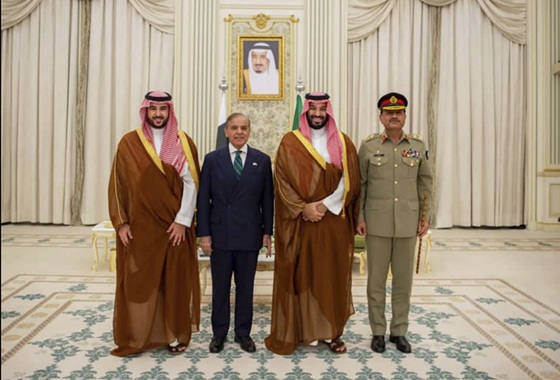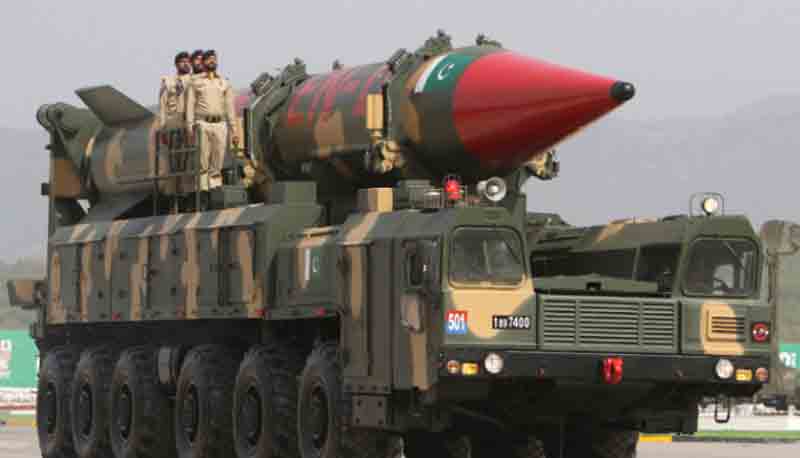On September 17, 2025, Saudi Arabia and Pakistan formalized a landmark Strategic Mutual Defense Agreement (SMDA) in Riyadh’s Al Yamamah Palace, cementing decades of security ties with a bold declaration: an attack on one is an attack on both. Signed during Pakistani Prime Minister Shehbaz Sharif’s state visit, hosted by Crown Prince Mohammed bin Salman, the pact encompasses joint military training, defense production, technology transfers, and potential troop deployments. While not explicitly a nuclear agreement, Pakistan’s Defense Minister Khawaja Mohammad Asif hinted on September 18, 2025, that Islamabad’s nuclear capabilities could be leveraged for Saudi Arabia’s defense, a statement tempered by Saudi officials emphasizing conventional cooperation. The deal, negotiated since mid-2024, gained urgency after Israel’s September 9, 2025, airstrikes on Doha, Qatar, which exposed Gulf vulnerabilities and doubts about U.S. security guarantees. This development has sparked intense speculation about whether the United States will respond with a new defense deal to reaffirm its commitment to Saudi Arabia, a key ally and top arms buyer.
The Pakistan-Saudi Defense Pact: A Strategic Shift
The SMDA marks a significant escalation in Pakistan-Saudi relations, building on historical financial ties, such as Saudi Arabia’s $3 billion loans to Pakistan. The agreement responds to regional anxieties, particularly after Israel’s Qatar strikes, which targeted Hamas leaders and raised questions about U.S. willingness to protect Gulf allies. Analysts view the pact as a Saudi hedge against threats from Iran and a signal of reduced reliance on Washington. While Pakistan’s nuclear arsenal adds a strategic deterrent, Saudi officials have clarified the focus is on comprehensive military cooperation, including co-production and capacity-building. The deal’s announcement, with Saudi Arabia notifying the U.S. only post-signing, underscores Riyadh’s assertive pivot toward diversified alliances, especially amid stalled U.S.-Saudi nuclear talks tied to Israel normalization since early 2025.
Recent U.S.-Saudi Defense Cooperation
The U.S. and Saudi Arabia have a robust defense relationship, highlighted by a record-breaking $142 billion arms package signed on May 13, 2025, during President Donald Trump’s visit to Riyadh. This deal, the largest in U.S. history, includes F-15 fighter upgrades (initial deliveries by late 2026), Patriot PAC-3 missile defense expansions (operational by 2027), maritime and anti-drone systems, and advanced C4ISR (command, control, communications, and intelligence) enhancements. Training programs for Saudi forces began in Q3 2025, supported by 40,000–50,000 U.S. troops stationed in the region, including at Prince Sultan Air Base. The agreement aligns with Saudi Arabia’s $600 billion investment in the U.S. economy, reinforcing bilateral ties. However, no new deals have been announced since the Pakistan-Saudi pact on September 17, 2025, leaving open the question of a U.S. response.
Speculative Scenarios for a New U.S.-Saudi Defense Deal
As of September 20, 2025, no new U.S.-Saudi defense agreement has surfaced, but the Pakistan pact’s implications make a response likely within 3–9 months (December 2025–June 2026). The U.S. faces pressure to counter Saudi Arabia’s strategic hedging, especially given Riyadh’s growing ties with China, Russia, and BRICS nations. Below are five speculative scenarios for how the U.S. might respond, with timelines and potential outcomes:
1. Accelerated Arms Package (December 2025–February 2026)
The U.S. could unveil a $50–80 billion supplemental arms deal, fast-tracking F-35 jet approvals (pending since May 2025) and expanding THAAD missile defense systems to counter Houthi and Iranian threats. This scenario could be triggered by Sharif’s U.S. visit in late October 2025 or discussions at the UN General Assembly (September 22–October 1, 2025). Likelihood: 70%. Such a deal aligns with historical U.S. responses to Gulf hedging, like the $110 billion package in May 2017. It would strengthen military ties but risks congressional opposition over F-35 transfers due to Israel’s concerns about its qualitative military edge.
2. Formal Security Pact (March–June 2026)
The U.S. might propose a mutual defense treaty akin to those with Japan or South Korea, guaranteeing protection against Iran or its proxies. This could include joint bases and integrated missile defenses, potentially sparked by Iranian escalation (e.g., a nuclear test or Gulf attacks) by November 2025. Likelihood: 50%. While Biden’s 2023–2024 treaty talks failed, Trump’s deal-making approach and competition from the BRICS summit (October 22–24, 2025, in Kazan) could revive this. However, it risks entangling the U.S. in Saudi-Iran conflicts and complicating Pakistan’s role.
3. Nuclear Cooperation Deal (April–June 2026)
To deter Saudi reliance on Pakistan’s nuclear arsenal, the U.S. could restart civilian nuclear energy talks stalled since early 2025, offering a safeguarded program tied to Israel-Saudi normalization. Progress might follow Saudi-Iran talks in late September 2025 or UN engagements. Likelihood: 40%. Saudi Arabia’s nuclear ambitions face U.S. nonproliferation concerns and Israel’s opposition (voiced September 2025), but China’s competing offers add urgency. This could unlock $100 billion in U.S. investments but risks fueling a regional arms race if safeguards fail.
4. Triangular U.S.-Saudi-Pakistan Framework (January–April 2026)
The U.S. could broker a trilateral security arrangement, integrating the Pakistan-Saudi pact into a U.S.-led framework with joint exercises and intelligence sharing to counter Iran. This might emerge if the U.S. views Pakistan’s role as stabilizing during Sharif’s October 2025 visit. Likelihood: 30%. While some repots suggest U.S. backing for the pact to leverage Pakistan, India’s objections (raised September 19, 2025) and nuclear proliferation concerns pose challenges. This would enhance U.S. influence but risk alienating India.
5. No Deal, Status Quo (Ongoing through 2026)
The U.S. might rely on the existing $142 billion deal, avoiding new commitments due to domestic constraints (e.g., congressional elections in November 2026) or Saudi overreach in BRICS. Saudi Arabia could then deepen ties with China (e.g., $20 billion deals in 2024–2025) or Russia. Likelihood: 20%. Inaction risks losing Saudi loyalty, especially as Qatar explores a similar pact with Pakistan by Q4 2025, making this scenario unlikely given U.S. strategic interests.
Key Timeline Triggers
– Late September–October 2025: The UN General Assembly (September 22–October 1) and Sharif’s U.S. visit (late October) could initiate U.S.-Saudi talks. Houthi threats (escalated September 19, 2025) or Iran’s response to U.S. sanctions (tightened September 19) may heighten urgency.
– November–December 2025:November–December 2025: Outcomes from the July 2025 BRICS Summit and mid-September 2025 Saudi-Iran talks could clarify Saudi Arabia’s alignment, prompting U.S. counteroffers like F-35 or THAAD deals by year-end.
– Q1–Q2 2026 (January–June): Regional escalations, such as Iranian nuclear advancements or Yemen conflict spikes by January 2026, could drive a major U.S. deal—arms, treaty, or nuclear—by March–June 2026.
– 2027 and Beyond: Delayed U.S. action risks Saudi Arabia pivoting to China or Russia, especially if Qatar secures a Pakistan pact by mid-2026, reshaping Gulf alliances.
Driving Factors
– Saudi Hedging: Riyadh’s post-pact notification to the U.S. and Gulf doubts post-Qatar strikes pressure Washington. X discussions highlight a U.S. need to “scramble” to retain influence, possibly via Sharif’s visit.
– Iran and Proxies: Houthi warnings (September 19, 2025) and Iran’s sanctions response increase Saudi demand for U.S. missile defenses or nuclear assurances.
– Geopolitical Competition: Saudi Arabia’s BRICS membership and Chinese deals ($20 billion in 2024–2025) push the U.S. to act, potentially by Q1 2026.
– Nuclear Concerns: U.S. monitoring of Pakistan-Saudi nuclear ties (noted September 18, 2025) may spur a preemptive nuclear energy deal to limit proliferation risks.
Conclusion
The Pakistan-Saudi defense pact has reshaped Middle East security dynamics, positioning a new U.S.-Saudi deal as highly probable by March 2026, with an accelerated arms package being the most likely outcome by February 2026. A formal treaty, nuclear cooperation, or trilateral framework are less certain but feasible if tensions escalate. The U.S. is unlikely to remain passive given competition from China and Russia. Key developments to watch include Sharif’s U.S. visit (late October 2025), UN General Assembly discussions (ending October 1, 2025), and Saudi-Iran talks (late September 2025). As the region teeters on the edge of escalation, the U.S. response will shape the future of Gulf alliances and the broader Middle East power balance.
Discover more from Defence Talks | Defense News Hub, Military Updates, Security Insights
Subscribe to get the latest posts sent to your email.





